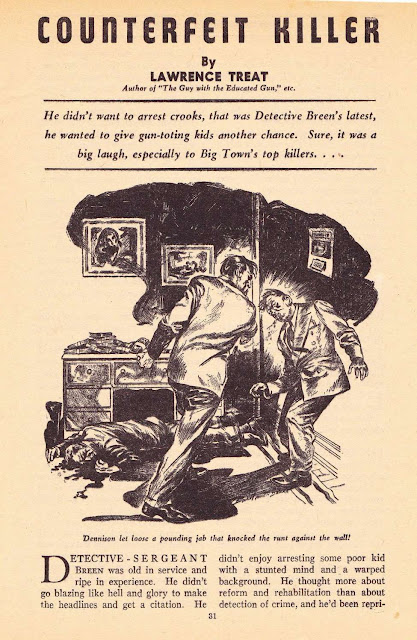By Lawrence Treat (Lawrence Arthur Goldstone, 1903–98).
First appearance: Detective Short Stories, November 1941.
Short story (10 pages).
Online at Comic Book Plus (HERE; select page 30).
"He didn't want to arrest crooks, that was Detective Breen's latest, he wanted to give gun-toting kids another chance. Sure, it was a big laugh, especially to Big Town's top killers. . . .". . . but doesn't an old adage assure us that he who laughs last, laughs best? When one crook experiences a windfall worth fifty thousand dollars and another crook tries to trick him out of that fortune with counterfeit bills, we're reminded of still another old adage about the absence of honor among thieves, with murder being the predictable result. Like so many criminals, the killer thinks he's too smart to get caught and sets about framing an innocent kid with a small mountain of forensic "evidence" guaranteed to get him a hot date with Old Sparky; but, while things do look dire for the kid, it'll be the man who has helped and defended him in the past, a policeman "old in service and ripe in experience," who'll get the last—and best—laugh.
Resources:
- According to FictionMags, from 1964 to 1981 Lawrence Treat had 39 stories published in Ellery Queen's Mystery Magazine showcasing his two longest-lasting series characters, Mitch Taylor and Bill Decker, the title of each story being patterned as "[capital letter] as in [one-word term]", e.g., "L as in Loot." Another character, Jub Freeman, seems to have appeared in novels as early as V as in Victim (1945), H as in Hunted (1946), and Q as in Quicksand (1947):
"With V as in Victim [short review HERE], Treat created the police procedural as we know it and established his place in crime-fiction history. In the story Mitch Taylor, 'a short, chesty man with dark dry hair brushed back over his forehead,' bemoans the policeman's lot, tries to find ways to improve his chances of promotion, and investigates a murder and hit-and-run accident, along with the coincidental connections between the two. Treat's innovation did not lie in introducing the importance of scientific evidence within the legal process, but in his characters – they were cops. Being a police officer is a job for them, they have their own particular jargon and slang, they tell cop tales, they share a professional bond, they do not like paper work, and the police station is shabby. However, in plotting Treat relied on the surprise ending of the traditional golden age detective story." — Books and Writers
- Wikipedia's stubby article about Treat is (HERE), the Books and Writers page has much more to say (HERE), his few film credits are on the IMDb (HERE), one of his non-series novels is discussed (HERE), and his New York Times obit is (HERE).
The bottom line: "A murder was never about brawn, it began and ended in the brain and the brain could justify anything."
— Bury Your Dead




No comments:
Post a Comment